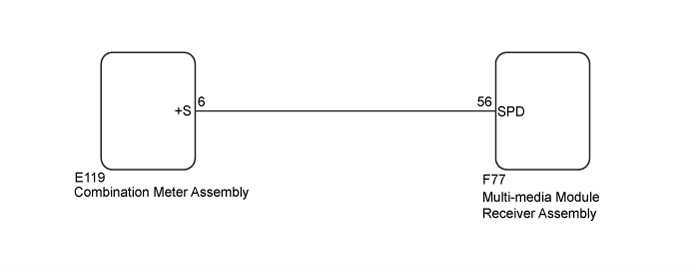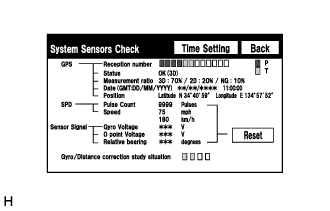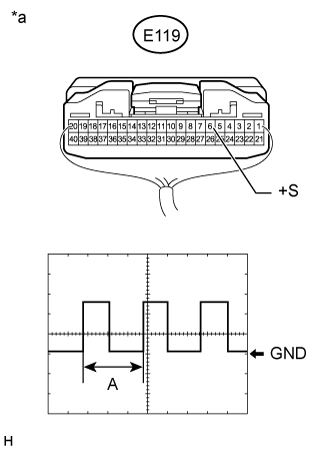Dtc B15C2 Speed Signal Malfunction
DESCRIPTION
WIRING DIAGRAM
INSPECTION PROCEDURE
CLEAR DTC
CHECK DTC
CHECK VEHICLE SENSOR (OPERATION CHECK)
CHECK COMBINATION METER ASSEMBLY (OUTPUT WAVEFORM)
CHECK HARNESS AND CONNECTOR (MULTI-MEDIA MODULE RECEIVER ASSEMBLY - COMBINATION METER ASSEMBLY)
DTC B15C2 Speed Signal Malfunction |
DESCRIPTION
The multi-media module receiver assembly receives a vehicle speed signal from the combination meter assembly and information from the navigation antenna assembly, and then adjusts the vehicle position on the map. The multi-media module receiver assembly stores this DTC when the difference between the speed information that the navigation antenna assembly receives and the SPD pulse received from the combination meter assembly becomes large.- HINT:
- A voltage of 12 V or 5 V is output from each ECU and then input to the combination meter assembly. The signal is changed to a pulse signal at the transistor in the combination meter assembly. Each ECU controls the respective systems based on the pulse signal.
- If a short occurs in any of the ECUs or in the wire harness connected to an ECU, all systems in the diagram below will not operate normally.
DTC Code
| DTC Detection Condition
| Trouble Area
|
B15C2
| A difference between the GPS speed and SPD pulse is detected
| - Meter / gauge system
- Multi-media module receiver assembly
|
WIRING DIAGRAM
INSPECTION PROCEDURE
- NOTICE:
- Depending on the parts that are replaced during vehicle inspection or maintenance, performing initialization, registration or calibration may be needed. Refer to Precaution for Navigation System (Click here).
Clear the DTCs (Click here).
Recheck for DTCs and check if the same DTC is output again (Click here).
- OK:
- No DTCs are output.
| 3.CHECK VEHICLE SENSOR (OPERATION CHECK) |
Enter the "System Sensors Check" screen. Refer to Check GPS & Vehicle Sensors in Operation Check (Click here).
While driving the vehicle, compare the "Speed" indicator to the reading on the speedometer. Check if these readings are almost equal.
- OK:
- The readings are equal or almost equal.
| OK |
|
|
|
| REPLACE MULTI-MEDIA MODULE RECEIVER ASSEMBLY (Click here) |
|
| 4.CHECK COMBINATION METER ASSEMBLY (OUTPUT WAVEFORM) |
Check the output waveform.
Remove the combination meter assembly with the connector(s) still connected (Click here).
Connect an oscilloscope to terminal E119-6 (+S) and body ground.
Turn the engine switch on (IG).
Turn a wheel slowly.
Check the signal waveform according to the condition(s) in the table below.
Item
| Condition
|
Measurement terminal
| E119-6 (+S) - Body ground
|
Tool setting
| 5 V/DIV., 20 ms./DIV.
|
Vehicle condition
| Wheel being rotated
|
- OK:
- The waveform is similar to that shown in the illustration.
- HINT:
- When the system is functioning normally, one wheel revolution generates 4 pulses. As the vehicle speed increases, the width indicated by (A) in the illustration narrows.
Text in Illustration*a
| Component with harness connected
(Combination Meter Assembly)
|
| 5.CHECK HARNESS AND CONNECTOR (MULTI-MEDIA MODULE RECEIVER ASSEMBLY - COMBINATION METER ASSEMBLY) |
Disconnect the F77 multi-media module receiver assembly connector.
Disconnect the E119 combination meter assembly connector.
Measure the resistance according to the value(s) in the table below.
- Standard Resistance:
Tester Connection
| Condition
| Specified Condition
|
F77-56 (SPD) - E119-6 (+S)
| Always
| Below 1 Ω
|
F77-56 (SPD) - Body ground
| Always
| 10 kΩ or higher
|
| | REPAIR OR REPLACE HARNESS OR CONNECTOR |
|
|
| OK |
|
|
|
| REPLACE MULTI-MEDIA MODULE RECEIVER ASSEMBLY (Click here) |
|


